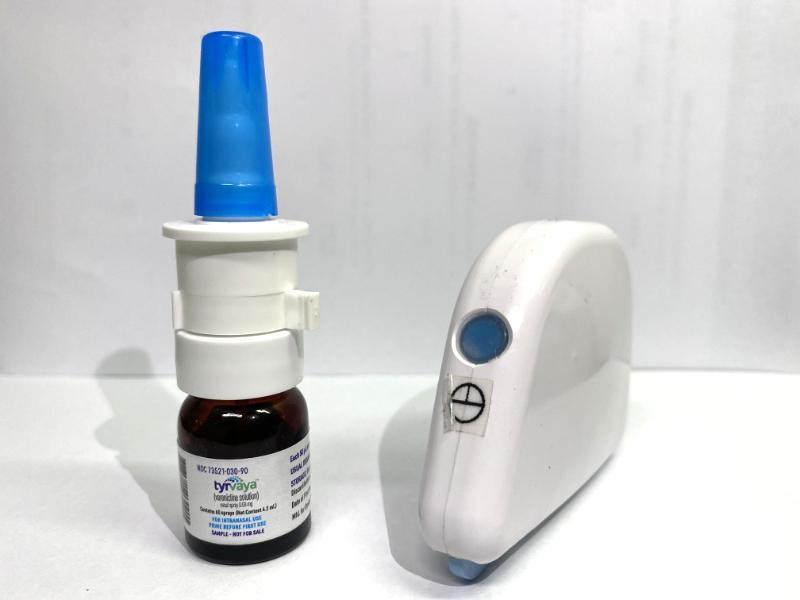Neurostimulation: How your nose can give relief from Dry Eyes
Ever have itchy or watery eyes? If you’ve been using a device, smartphone or staring at a screen, you may have experienced symptoms of dry eyes.
You may have felt itchy eyes, watery eyes, tired eyes, red eyes, filmy/smeary vision, light sensitivity, stingy eyes.
You may have even used eye drops for dry eyes. Artificial tears try to mimic the normal layer of tears. However, they tend have a small number of ingredients. Relief is often temporary.
Did you know that our normal layer of tears are more than just salt and water?
According to A/Prof. Laura Downie (The University of Melbourne) our normal tears contain around two thousand ingredients. They are a complicated includes a mixture of:
- Nerve growth factors
- Proteins
- Mucins
- Lipids
According to the Tear Film and Ocular Surface Society (TFOS DEWS II):
“Dry eye is a multifactorial disease of the ocular surface characterized by a loss of homeostasis of the tear film, and accompanied by ocular symptoms, in which tear film instability and hyperosmolarity, ocular surface inflammation and damage, and neurosensory abnormalities play etiological roles”
When your tears are in balance (homeostasis), the normal layer of tears protects your eyes- similar to a wetsuit that protects you from the environment.
Dry eyes causes a reduced volume and quality of tears to protect your eyes. That is, the tears become more stagnant.
Meibomian Gland Dysfunction (MGD) is one of the most common causes of dry eyes. MGD results in clogged Meibomian Glands. This triggers the Meibomian Glands to signal that they are full of oil. So the nervous system reduces Meibum production.
Chronic dry eyes can lead to exposure of corneal nerves. These nerves can become over or undersensitized.
So they signal to the body that there is either neuropathic (hypersensitive to even the smallest amount of dryness), or neurotrophic (undersensitive and ulcers form on the front of the eyes (cornea).
Left untreated, dry eyes is frequently progressive. This can lead to significant pain or fluctuating vision.
However, artificial tears often don’t work for long.
Neurostimulation for Dry Eyes
Recently, new dry eye treatments have shown promise for improving dry eye signs and symptoms.
Neurostimulation is where systems in the body are switched on by activating certain nerves.
The human body already uses neurostimulation to produce normal tears. In fact, each breath helps to switch on a normal level of tears for your eyes. Around 34% of our normal tear levels comes from airflow through your nose.
The Parasympathetic Nervous System via the Trigeminal Nerve helps regulate the production of tears. It switches on all layers of tears via the Lacrimal Glands, Meibomian Glands, and Goblet Cells.
Stimulating this nerve provides the perfect mix of natural tears to help dry eyes.
Two new approaches include the iTear100 (electronic device) and Tyrvaya (varenicline) nasal spray.

Check out this table for comparison of the two treatments:
| iTear100 | Tyrvaya (varenicline) | |
| FDA approval date | 1st May 2020 | 18th Oct 2021 |
| How it works | Electronic device (applied externally near the border of nose and cheek) | Nasal spray (applied inside the nose) |
| FDA Study detailsGender Age (Mean, SD)Baseline Schirmers ScoreBaseline Eye Dryness ScoreCriteria | Female (76%)50-70 years (largest group, but included 21 years and above) 167 participants (in two studies TEAR-1 and TEAR-2) | Female (74%)61 years (12.5 years)5.1mm (2.9mm)EDS 59.3 (21.6)Open to everyone (minimal dry eyes to severe dry eyes)1000 participants (in two studies ONSET-1 and ONSET-2) |
| FDA Study ResultsAnaethetized Schirmer Score | At 30 Days 34% achieved greater than 10mm Schirmer Score TEAR1- 9.4mm average Schirmer score TEAR2- 22mm increase in Schirmer Score Significant improvement in OSDI Score 44% of patients were able to reduce using artificial tears 23.3% were able to eliminate drops altogether | At Week 4 52% achieved greater than 10mm increase in Schirmer Score (vs 14% of vehicle treated patients) 47% achieved greater than 10mm increase in Schirmer Score in ONSET-2 Study (vs 28% of vehicle treated patients) Mean change 11.7mm in ONSET-1 Study (vs 3.2mm with vehicle) 11.3mm in ONSET-2 Study (vs 6.3mm vehicle) |
| Common Side Effects | Sneezing Dizziness 3% Headache | Sneezing- 82% Cough Throat irritation Nose irritation |
| Available date | Currently available | Currently available |
These treatments not only give instant relief, they also help improve the quality of tears over time. Used twice daily, this clinical study showed that improvements were maintained over six months duration.
Tyrvaya vs iTear100 Videos
Dr Neal Guymon (Dr EyeGuy) reviews Tyrvaya:
Dr Melanie Denton (Eye School with Dr D) reviews Tyrvaya vs iTear100:
Who is Neurostimulation for?
Neurostimulation is not just for people with severe dry eyes. In fact, the FDA studies showed improvement for people with minimal dry eye symptoms.
What are the advantages of Neurostimulation?
- Easier instillation for people who struggle to use artificial tears.
- No preservatives are instilled into the eyes, so comfort is maintained
- The best part is you get instant comfort for your eyes.
Summary
In summary, neurostimulation is a promising dry eye treatment. It instantly switches on the right quality of natural tears for the eyes. The benefits can be maintained over time.
Whether you have minimal dry eye symptoms or significant dry eye discomfort, talk with your eye doctor about neurostimulation for your eyes.

